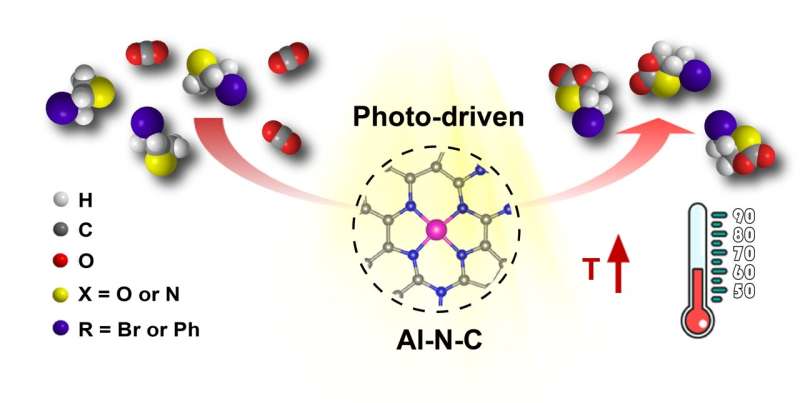Photo-driven catalytic process based on the Al–N–C catalyst. Credit: NIMTE
Prof. Chen Liang's group and Prof. Lu Zhiyi's group at the Ningbo Institute of Materials Technology and Engineering (NIMTE) of the Chinese Academy of Sciences (CAS) proposed a highly-active carbon-based catalyst, which can directly utilize renewable energy (e.g., solar energy) to improve the efficiency of photo-driven CO2 cycloaddition effectively. The study was published in Advanced Materials.
In recent years, the increasing greenhouse gas (mainly CO2) emissions have exacerbated the global warming and ocean acidification. With the aim to peak CO2 emissions and achieve carbon neutrality, the elimination of CO2 based on the capture and conversion of CO2 is urgently needed. The cycloaddition of CO2 with epoxides to generate cyclic carbonates has attracted extensive attention thanks to the diverse application of products.
By virtue of a versatile molecule-confined pyrolysis strategy, researchers at NIMTE proposed and synthesized a semiconductive Al-N-C catalyst possessing high density of atomically dispersed Al-N4 motifs.
The Al and N species serves as Lewis acid and base sites, respectively, which are combined to facilitate the substrate activation for the photo-driven CO2 cycloaddition reactions. Under light irradiation, the synthesized Al–N–C catalyst showed excellent catalytic performance (≈95% conversion, reaction rate = 3.52 mmol g-1 h-1) for the CO2 cycloaddition reaction.
In addition, both experimental and theoretical analysis revealed that light irradiation facilitated the photo-generated electron transfer from the semiconductive Al–N–C catalyst to the epoxide reactant, contributing to the high-efficiency formation of a ring-opened intermediate through the rate-limiting step. This process constitutes a new activation mechanism for CO2 cycloaddition reaction.
This study has provided a novel approach for high-efficiency CO2 cycloaddition based on the integration of atomically dispersed Al species and photothermal effect, and shed light on the future design of advanced catalysts for diverse catalytic reactions.
More information: Qihao Yang et al, Atomically Dispersed High‐Density Al–N 4 Sites in Porous Carbon for Efficient Photodriven CO 2 Cycloaddition, Advanced Materials (2021). DOI: 10.1002/adma.202103186
Journal information: Advanced Materials
Provided by Chinese Academy of Sciences
























